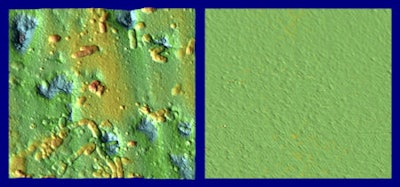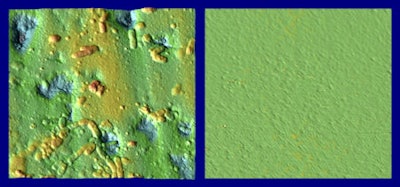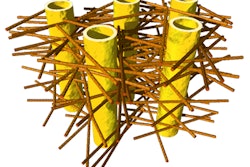
Researchers from Clarkson University have discovered a new method for protecting teeth from cavities: ultrafine polishing with silica nanoparticles.
Clarkson University Center for Advanced Materials Processing (CAMP) Professor Igor Sokolov, Ph.D., M.Sc., and graduate student Ravi M. Gaikwad adopted polishing technology used in the semiconductor industry (chemical-mechanical planarization) to polish the surface of human teeth down to nanoscale roughness, according to the university.
Roughness left on the tooth after the polishing is just a few nanometers -- one-billionth of a meter, or about 100,000 times smaller than a grain of sand.
 |
| Left, bacteria and roughness are clearly seen on the human tooth surface before nanoparticle polishing. Right, the tooth surface after polishing. Images courtesy of Clarkson University. |
Teeth polished in this way become too "slippery" for the "bad" bacteria that is responsible for the destruction of dental enamel, according to Sokolov and Gaikwad. As a result, the bacteria can be removed fairly easily before they cause damage to the enamel.
Although silica particles have been used before for tooth polishing, polishing with nano-sized particles has not been reported, according to the researchers. They hypothesize that such polishing may protect tooth surfaces against the damage caused by cariogenic bacteria because the bacteria can be removed easily from such polished surfaces.
Their findings were published in the October issue of the Journal of Dental Research (Vol. 87:10, pp. 980-983).



















